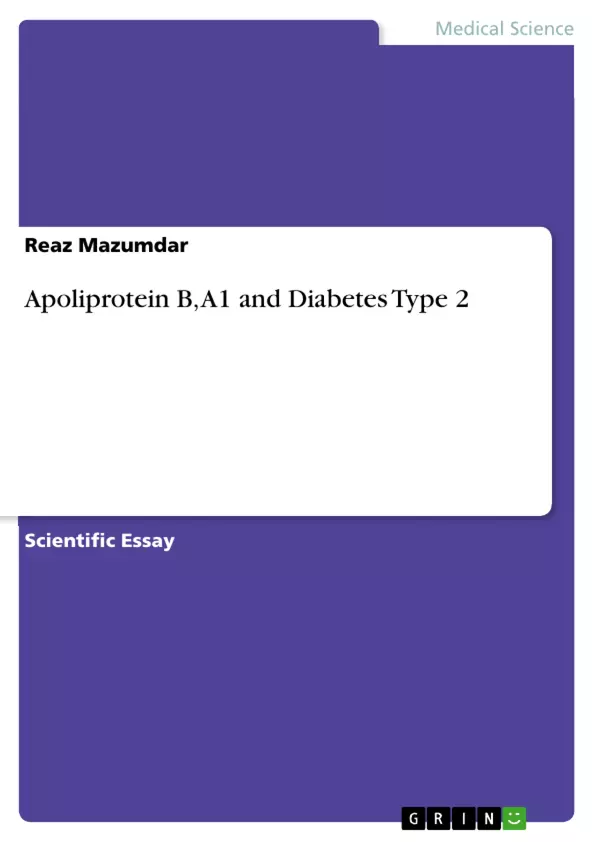This paper examines the relations between Apoliprotein B, Apoliprotein A1 and Diabetes Type 2.
Diabetes mellitus refers to a group of metabolic disorders of multiple aetiology and characterized by chronic hyperglycaemia with disturbances of carbohydrate, fat and protein metabolism resulting from defects in insulin secretion, insulin action, or both.
The effects of diabetes mellitus include long–term damage, dysfunction and failure of various organs. Diabetes mellitus may present with characteristic symptoms such as thirst, polyuria, blurring of vision, and weight loss. In its most severe forms, ketoacidosis or a non–ketotic hyperosmolar state may develop and lead to stupor, coma and in absence of effective treatment, death.
Often symptoms are not severe, or may be absent, and consequently hyperglycaemia sufficient to cause pathological and functional changes may be present for a long time before the diagnosis is made. It is a major health problem in all nations. Diabetes is the single, most important metabolic disease, widely recognized as one of the leading causes of death and disability worldwide.
This devastating disease can affect nearly every system in the body. It can cause blindness, lead to end stage renal disease, lower extremity amputations and increase the risk for stroke, ischemic heart disease, peripheral vascular disease, and neuropathy. Diabetic macro and microvascular complications are resulting in increased disability and enormous health care costs.
Inhaltsverzeichnis (Table of Contents)
- Apoliprotein B, A1 and Diabetes Type 2
- Classification of Diabetes
- Type 1 diabetes mellitus
- Type 2 Diabetes Mellitus
- Gestational Diabetes
- Other specific types
- Prediabetes
- Impaired glucose regulation (IGR) or "Prediabetes"
- APOLIPOPROTEINS
- Apolipoprotein A1
- Apolipoprotein B
Zielsetzung und Themenschwerpunkte (Objectives and Key Themes)
This work focuses on the role of apolipoproteins B and A1 in the development and progression of type 2 diabetes. It examines the complex relationship between these proteins, insulin resistance, and the pathophysiology of diabetes.
- The classification and aetiology of different types of diabetes, including type 1, type 2, gestational diabetes, and other specific types.
- The concept of prediabetes, including impaired glucose tolerance (IGT) and impaired fasting glucose (IFG).
- The impact of glucose and insulin on apolipoprotein A1 gene expression.
- The role of insulin resistance in the expression of apolipoprotein A1.
- The relationship between insulin and apolipoproteins B and A1.
Zusammenfassung der Kapitel (Chapter Summaries)
- Apoliprotein B, A1 and Diabetes Type 2: This chapter introduces the topic of diabetes, its classification, and the prevalence of the disease globally. It highlights the importance of diabetes as a major health problem and its potential impact on various organ systems.
- Classification of Diabetes: This chapter provides a detailed overview of the different types of diabetes, including type 1, type 2, gestational diabetes, and other specific types. It discusses the underlying causes and characteristics of each type.
- Type 1 diabetes mellitus: This chapter focuses on type 1 diabetes, which is characterized by autoimmune destruction of pancreatic beta cells. It explores the causes, symptoms, and management of this type of diabetes.
- Type 2 Diabetes Mellitus: This chapter examines type 2 diabetes, which is characterized by insulin resistance and/or abnormal insulin secretion. It discusses the prevalence, risk factors, and treatment options for type 2 diabetes.
- Gestational Diabetes: This chapter delves into gestational diabetes, a condition that develops during pregnancy. It discusses the causes, risks, and management strategies for gestational diabetes.
- Other specific types: This chapter explores less common forms of diabetes, including those with identifiable underlying causes or disease processes.
- Prediabetes: This chapter introduces the concept of prediabetes, which refers to blood glucose levels that are higher than normal but not yet diabetic. It explains the different stages of prediabetes and their implications for health.
Schlüsselwörter (Keywords)
The main keywords and focus topics of this work include diabetes, apolipoproteins, insulin resistance, glucose homeostasis, type 1 diabetes, type 2 diabetes, gestational diabetes, prediabetes, impaired glucose tolerance (IGT), impaired fasting glucose (IFG), and apolipoprotein A1 and B.
- Quote paper
- Reaz Mazumdar (Author), 2008, Apoliprotein B, A1 and Diabetes Type 2, Munich, GRIN Verlag, https://www.grin.com/document/338391



